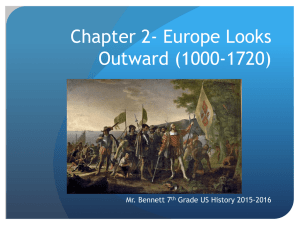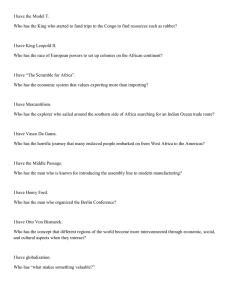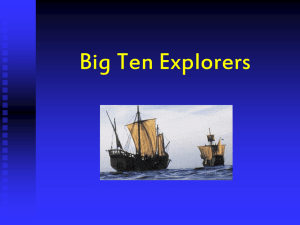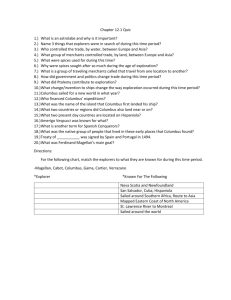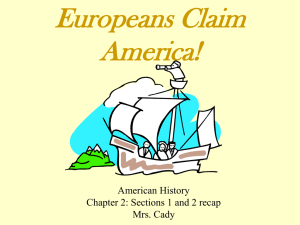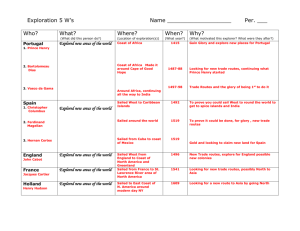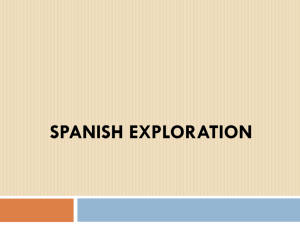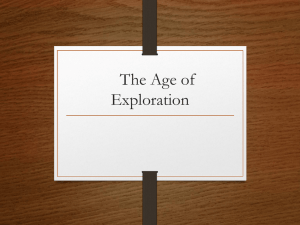Reasons for Exploration
advertisement
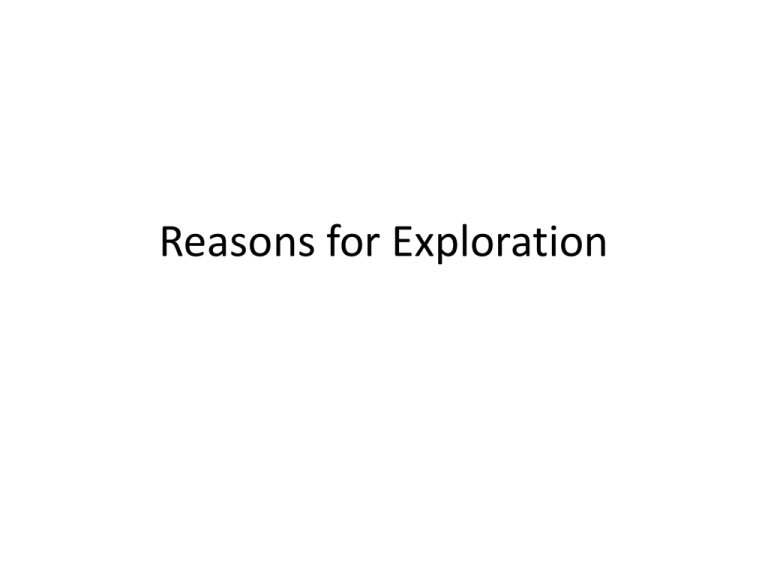
Reasons for Exploration Factors That led to Exploration • Several factors during the 1400s set the stage for European exploration of the Americas. These included the following: – During this time small areas led by nobles had joined together to form nations led by kings and queens. These included England, Portugal, Spain, and France. – There had been many improvements in science and technology including improvements in navigation instruments and ships. – There was an interest in exploration and gaining knowledge of new places. – New ways to print books had made The Travels of Marco Polo available to more people. This was about an Italian who had traveled to Asia in the late 1200s and found jewels, spices, gold, silk and other “treasures” there. – Europeans wanted the trade goods with Asia. The World in 1507 The World in 1581 Comparing Primary Sources • What are some differences between the map from 1507 and 1581? • Why do you think the map from 1581 is more accurate? Trade Routes Across Land Problems With Land Routes • • • • • Round Trip travel took months to complete Bandits would rob and murder travelers Many land routes were closed by local leaders Travel led through mountains and deserts Wars were frequent along the trade routes Time to Think • After reading about some of the problems with trade routes across land, I want you to think about the following questions: – Should Europeans continue to trade with people in Asia? – If so, how could Europeans trade with Asians in faster and safer ways? The Need for New Routes • Portugal sent Bartolomeu Dias and Vasco da Gama to find a sea route to India and China • Dias sailed around the southern tip of Africa in 1487 • Da Gama sailed all the way to India between 1497 and 1499 • Portugal became more wealthy and powerful by using these trade routes Early Sea Routes to India How long did Vasco da Gama’s round trip voyage to India take? Do you think land or sea routes were more efficient at this time? Spain • On August 3, 1492 Columbus left Spain with three ships and 90 sailors. On October 12, 1492 he anchored off an island in the Caribbean that he named San Salvador. He claimed the island for Spain. • He was convinced he had made it to the Indies of Asia. Therefore, he called the Native Americans living on the island “Indians.” • Columbus made three more voyages to the Americas, each time believing he was in Asia. Time to Think • How do you think the Native Americans on San Salvador felt about Columbus and his explorations? • What effect do you think the voyages of Columbus had on other European countries? England • The voyage of Columbus caused many European kings and queens to consider sending ships across the Atlantic to Asia. • In 1497 the King of England paid an Italian sailor, Giovanni Caboto, to head a voyage across the Atlantic. • Caboto sailed far north of Columbus’s route and probably reached present-day Newfoundland. • He returned to England claiming he had found China. • He became a hero in England and was given the English name John Cabot. Spain • The explorations of Spain led to this country making claims to the Americas. • Spanish explorers known as “conquistadors,” or conquerors, pushed deeper and deeper into North and South America. • The Spanish were obsessed with finding gold in the Americas. • These conquerors claimed all the land they explored for Spain. • How do you think Native Americans reacted to these encounters? Spain • In the 1500s, Spain had become the richest nation in Europe having taken loads of gold and silver from the Americas. • Spain appeared to control the southern sections of these new continents so other European countries began to look for new trade routes to Asia hoping they could get rich by trading for the valuable goods there. The Magellan Route The Magellan Route • One option was to take the Magellan route around South America. • What would be some problems with this route? • This led some countries to come up with another plan. They hoped to find a water passage across the continent of North America, which they assumed was not very wide. They called this passage the “Northwest Passage.” France and the Search for the Northwest Passage • Giovanni da Verrazano – – – – • Jacques Cartier – – – – – • In 1524 this Italian explorer was sent by France to locate the Northwest Passage. He reached what is now the North Carolina coast and headed north. He sailed into what is now New York Bay and landed on present day Staten Island. He sailed north again to present day Nova Scotia, but did not find the water route west he was looking for. In 1534 this French navigator sailed for his home country in search of gold and the Northwest Passage. He sailed near the mouth of the St. Lawrence River. On his second voyage he sailed up the St. Lawrence River looking again for the Northwest Passage. He hit rapids near what is now Montreal. In 1541 on his third voyage he sailed still further up the St. Lawrence River to what is now Quebec. As a result of these voyages, a fur trading business developed between the French and Native Americans. Samuel de Champlain – – In 1603 this French explorer was sent to map places where beaver could be found. He sailed along the St. Lawrence River for five years and eventually traveled into the Great Lakes region. Early Explorers Routes and Land Claims European Land Claims in the Americas Time to Think • What led to increased exploration of the world in the 1500’s? • How did exploration lead to colonies being formed in the Americas? • In your opinion, what problems might arise from the exploration of the Americas?
